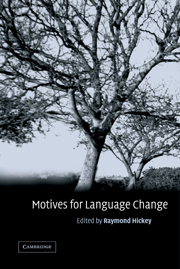Book contents
- Frontmatter
- Contents
- Notes on the contributors
- Acknowledgements
- Introduction
- Part I The phenomenon of language change
- Part II Linguistic models and language change
- Part III Grammaticalisation
- Part IV The social context for language change
- Part V Contact-based explanations
- Part VI The typological perspective
- 14 Reconstruction, typology and reality
- 15 Reanalysis and typological change
- Index
- References
15 - Reanalysis and typological change
Published online by Cambridge University Press: 22 September 2009
- Frontmatter
- Contents
- Notes on the contributors
- Acknowledgements
- Introduction
- Part I The phenomenon of language change
- Part II Linguistic models and language change
- Part III Grammaticalisation
- Part IV The social context for language change
- Part V Contact-based explanations
- Part VI The typological perspective
- 14 Reconstruction, typology and reality
- 15 Reanalysis and typological change
- Index
- References
Summary
Introduction
The concern of the present chapter is to examine the typological change in morphology which took place in Irish and which sets it off both from members of related Indo-European subgroups and partly from other Celtic languages, i.e. the P-Celtic languages. This typological change resulted in the rise of a system of initial mutations (a common Insular Celtic development) and the rise of functional palatalisation in Irish, in all probability due to reanalysis by language learners triggered by the demise of inherited inflections from earlier stages of Celtic. This kind of typological change is quite unique among the Indo-European languages which generally have used other devices to accommodate the shift from synthetic to analytic type. The uniqueness of the Irish solution makes it worthwhile examining it as an instance of what constitutes a possible language change and so match the tenor of the other contributions to the present volume. The framework I am adopting is a broadly typological perspective which attempts to give a unified interpretation of several apparently disparate phenomena which appear in the earliest history of Irish. The period at which the changes would seem to have begun is the immediately pre-Old Irish period (before 600) and the typological adjustment continued throughout the remainder of the recorded history of Irish, albeit with disturbances due to developments on linguistic levels other than that of morphology.
- Type
- Chapter
- Information
- Motives for Language Change , pp. 258 - 278Publisher: Cambridge University PressPrint publication year: 2003
References
- 3
- Cited by



